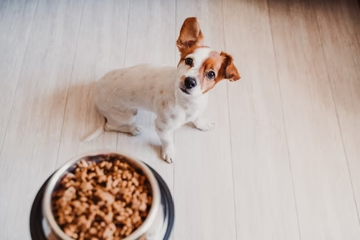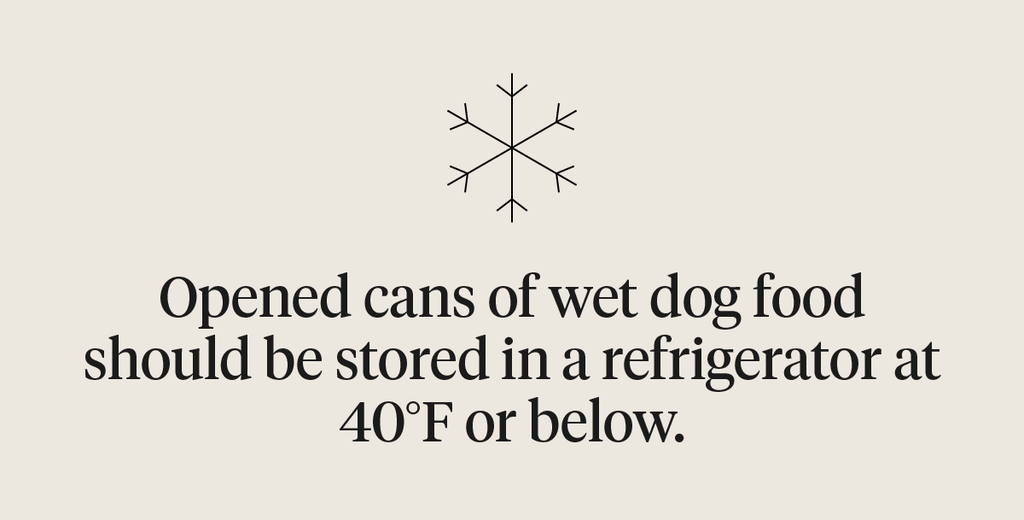9 Min Read
How To Store Dog Food
Key takeaway

Why pet owners are switching to online vet care with Dutch
-
Prescriptions delivered free to you
-
Fast access to Licensed Vets over video
-
Unlimited video visits and follow-ups
If you own a dog, you’re constantly adding various pooch-related items to your shopping list; things like toys, treats, poop bags, and of course, dog food. Many dog owners buy dry dog food in bulk and often just pour it into a container to prevent it from going stale and to keep it easily accessible. But is this the best way to store it? Keeping your dog’s food fresh is vital to their health and wellbeing, so it’s important to store it properly.
Regardless of which type of food you choose to feed your furry friend, improperly stored kibble or wet food can cause anything from loss of nutrients to food poisoning. Fortunately, there are simple steps you can take to follow proper dog food storage. Let’s explore some of the best ways to keep food fresh, nutrient-rich, and delicious for your pup.
- Why Proper Storage of Dog Food is Essential
- What’s the Best Way to Store Dry Dog Food?
- What’s the Best Way to Store Wet Dog Food?
- Other Food Safety Tips
- FAQs
- Final Notes
Why Proper Storage of Dog Food is Essential
Why is it so essential to store dog food correctly? The number one reason is to prevent it from going bad and potentially making your dog sick. An unplanned trip to the emergency vet can be scary for both dog and owner, not to mention expensive. This is why it’s best to try and prevent the likelihood of your dog getting food poisoning from improperly stored food.
It’s also important to keep the food inaccessible to your dog in between meals. Overeating or eating on an irregular schedule can cause them to have digestive problems and can lead to unhealthy weight gain in the long run.¹ Notably, labradors in particular, are genetically predisposed to engage in uncontrolled eating if given access to large amounts of food, so this is important to keep in mind if you own a labrador or a labrador mix.²
The FDA states that proper storage of pet food — including treats — helps maintain the nutritional value of the food. Humidity, extreme heat, or cold, can have a significant effect on dog food, so dry kibble should always be stored in a cool, dry area to minimize the adverse effects of these environmental factors. Lastly, storing your dog’s food properly allows you to be aware of its expiration date and any recalls by the manufacturer.¹ At the end of the day, the main goal is to make sure your furry companion gets all the nutrients they need and that they don’t feel hungry or get ill because of stale or spoiled kibble.
What’s the Best Way to Store Dry Dog Food?
Any dog food you buy will usually have instructions for proper storage written on the outside packaging. While we often store our own food leftovers in plastic or glass containers, the FDA actually recommends keeping treats and dry dog food in its original bag. This makes it easy for you to access important information, like expiration or use-by dates, as well as the manufacturer details.¹ In some cases, pet food may be recalled due to bacterial contamination, improper nutrient levels, or foreign material in food that is already being sold on the market.³ Having the product serial number handy can help you determine whether your dog’s food should be disposed of.
Dry dog food should always be stored in a cool, dry area (less than 80°F) away from direct sunlight and extreme moisture. Conditions that are too hot, cold, or moist can cause the nutrients in the kibble to break down. It might even start to go bad, which can make your dog sick.

Many dry dog food bags are re-sealable, making it even more convenient for storage. However, if you would still prefer to store kibble in a container, make sure that it will stay fresh and try to keep the original bag handy in case you need to reference specific information. You can also tape the packaging information to the outside of the container. Just remember to update it when you refill the container with a new bag of kibble. Alternatively, you can simply place the bag inside your container of choice. This can be helpful if your dog is likely to get into the food easily.¹
What’s the Best Way to Store Wet Dog Food?
Although there are advantages to both wet and dry dry dog food, wet food is a bit more tricky to keep fresh, compared to dry kibble. Unopened cans of wet food have a long shelf life and can be stored in the same way as dry kibble. However, once opened, wet food needs to be stored in the refrigerator and shouldn’t be left in your dog’s bowl for too long (ideally, no more than 4-6 hours, especially on hot days). Make sure that your refrigerator is set to 40°F or below. It’s always better to dispose of unused wet food if you are unsure of its condition.¹
It’s even more important to regularly wash your dog’s bowl and any utensils if you feed them wet food, as there is a higher chance of bacteria developing. Even small pieces of wet food can put your dog at risk of food-borne illnesses if left at room temperature for too long.¹
Try to put a lid or plastic wrap over any opened wet food cans in the fridge. Pouches can be put in a small sandwich bag. This will help retain moisture and reduce odor transfer, increasing the likelihood of being able to use it for a second meal. If you think the food is too cold after refrigeration you can try heating it in the microwave for a maximum of 10 seconds. Your dog might find warm wet food more enjoyable.⁴
Generally, canned dog food is safe for your dog to eat for 3-7 days after opening, although this might vary slightly, depending on the specific type of food. For example, canned paté lasts in the fridge for about 5-7 days, while stews tend to last about 3-5 days. Any wet food that’s high in fish oil should be consumed within 3 days of opening, because it tends to have a strong odor that can become unpleasant fairly quickly.⁴
Other Food Safety Tips
Always wash and dry your dog’s food bowl regularly, particularly if you feed them wet food. Treats should be kept in a secure location to prevent your pooch from accessing them behind your back. Dog treats are usually dry, so they can be stored in a cool, dry place no higher than 80°F, just like kibble. Open treat bags should be placed inside an airtight container or re-sealable bag. It’s important to seal soft treats properly, as exposure to air can cause them to go hard or stale. You might be inspired to make homemade doggy treats from time to time. Store them in the refrigerator in a bag or container to maintain maximum taste and freshness.⁵
As hard as we try to feed our furry friends nutritious, healthy, good-quality food, there is always a risk of food-related illness. So, what do you do if this happens? The best way to determine if your dog has eaten spoiled food is to immediately check the food itself. Be on alert if you notice that wet food has a foul smell, leakage, or irregular consistency. Wet food pouches might also look swollen if they’ve gone off. Mold is another indicator of spoiled food.
You know your dog best. If you suspect that they might have eaten bad food, monitor them and seek veterinary care if they show symptoms of being ill. Symptoms look out for include⁶:
- Vomiting (particularly right after eating)
- Constipation or diarrhea
- Twitching
- Low energy
- Sudden reduced appetite
- Standing in a hunched way (this can be due to stomach pain)
Sometimes, it can take a couple days for symptoms to appear, although it’s more likely that your dog will vomit soon after consuming the contaminated food. Your vet will be able to determine the best course of treatment to make your dog feel better. They might use an injection to induce vomiting if your dog hasn’t been able to do so naturally. Blood tests, an abdominal ultrasound, or IV fluids may be necessary in more extreme cases.
FAQs
How long is dog food good for?
It varies depending on the brand. Check the manufacturer information on the packaging.
Is it OK to store dog food in a plastic container?
Yes. Just make sure to have the original packaging information on hand. Store in an airtight container in a cool, dry place.
Should you keep dog food in a bag or a container?
Both are fine. Bags should be re-sealable and containers should be airtight to maintain freshness and nutrient quality. Keep out of reach of your dog, children, and other pets.
Does dog food go bad in a sealed container?
Yes, it can. Wet food can be stored safely for about 3-7 days, depending on the brand and type of food. Kibble will keep for a long time if stored properly. Always pay attention to manufacturer guidelines and expiration dates on the packaging.

Final Notes
Once you have decided which dog food to purchase, it’s equally important to store it properly in order to prevent bacterial contamination, loss of nutrients, and a decrease in flavor. Kibble is often sold in a convenient, re-sealable bag, but some dog owners may prefer to store it in their own containers. Always store dry dog food in a cool, dry place without excess moisture.
Not sure how to best store your dog food or have you switched to a different type of dog food? Ask a Dutch-affiliated vet. The vets at Dutch.com are highly qualified professionals, who can offer you advice about your pet’s nutrition via online consultations, so you can get all the answers you need from the comfort of your own home. Try Dutch’s tele-vet services today and receive expert guidance anytime.
Share
References
-
“Proper Storage of Pet Food & Treats.” Center for Veterinary Medicine , Apr. 2020, www.fda.gov/animal-veterinary/animal-health-literacy/proper-storage-pet-food-treats#:~:text=Proper%20storage%20of%20pet%20food%20and%20treats%20maintains%20the%20products,your%20cat’s%20special%20diet%20food.
-
Raffan, Eleanor, et al. “Genetic Variant May Help Explain Why Labradors Are Prone to Obesity.” University of Cambridge, 3 May 2016, www.cam.ac.uk/research/news/genetic-variant-may-help-explain-why-labradors-are-prone-to-obesity
-
Heinze, Cailin R. “The Reality of Pet Food Recalls.” Clinical Nutrition Service at Cummings School, 16 Mar. 2022, https://vetnutrition.tufts.edu/2017/05/pet-food-recalls/#:~:text=Most%20common%20reasons%20for%20pet,treats%20such%20as%20pig%20ears
-
Aide, Alicia. “How to Properly Store Pet Food.” Hillcrest Animal Hospital, 14 Apr. 2022, www.hillcrestanimalhospital.ca/properly-store-pet-food/
-
“Keeping Things Fresh: Pet Food Storage Guide.” Fetch & Stay, 19 July 2018, https://fetchandstay.ca/blogs/news-blog/keeping-things-fresh-pet-food-storage-guide
-
“My Dog Has Eaten Something Harmful.” The People’s Dispensary for Sick Animals (PDSA), July 2019, www.pdsa.org.uk/pet-help-and-advice/pet-health-hub/symptoms/my-dog-has-eaten-something-harmful
